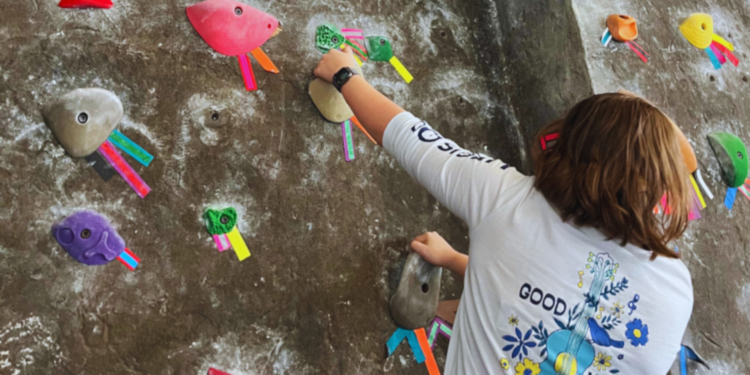Climbing walls offer a niche community in campus recreation. It’s something special to bond with others over a common interest. In climbing — like other sports — you bond with people who enjoy the same physical challenges. I must admit, when our indoor climbing wall opened around 10 years ago, I thought it was a great program to add and didn’t think twice about trying it for myself. In my mind were the movies of Tom Cruise or Sylvester Stallone hanging and maneuvering across a rocky façade. I associated rock climbing with upper body strength I didn’t have. When I did try it, it was because one of my female staff invited me to. We went together and with just a little instruction on using my legs to push up and my arms for reaching holds, she gave me the confidence to try something I never thought I could do. And I made it to the top.
My misconception about strength needed to participate was my barrier. For others, it may be the heights or the terminology — and let’s be honest, terminology is a nice way to say climbing community slang — that keep them from trying or sticking around. In the Recreation and Wellness Department at the University of North Florida (UNF), coordinator Rachel Taylor is working to break down these barriers through intentional, creative programming. Rachel’s been climbing since she was 17 years old, getting her start in outdoor climbing in Utah. Moving to Florida, she followed her love of climbing to indoor gyms. Overseeing the 34-foot indoor climbing wall at UNF, Rachel is a natural ambassador for the benefits of climbing and what the climbing community offers.
Here are programs Rachel and her climbing wall staff are using to introduce the sport to newcomers and breakdown barriers or misconceptions about the sport. These program ideas are based on highlighting fun and building community:
Beginner Climbing Clinics
These clinics are great for teaching beginner climbers basic skills and terms seasoned climbers use. Common terminology goes along way in being comfortable and feeling like they fit in. While technique can take years to perfect, one-on-one coaching can clarify common climbing mistakes — for example, underutilizing your leg strength to push your upper body toward the next hold. Or perhaps exhausting your arm muscles by leaning away from the wall thus keeping your biceps engaged and locked out is something else you can learn. Incorporating small changes into your climbing can lead to great progress on the wall. It can all start with an experienced suggestion from our staff.
Add-on or HORSE
To add a challenge for experienced climbers, staff and climbers will take turns creating a route up the wall. Each individual will add a new move to the climb until it becomes too difficult for their peers. This expands the creative climbing process and adds new uses to a wall with limited space.
Grip Olympics
This idea came from the student staff. Knowing that fingers do a lot of the work to hold body weight on holds, staff came up with the idea to introduce grip equipment, including a rotating cylinder, mounted rubber ball, and 2-milimeter finger hold that can test how much you can pick up with your fingertips. This has turned into a fun competition and the equipment has been kept out for use in general grip training.
Girls on the Rocks
Let’s get more girls to climb. Rachel recognizes the intimidation this sport may have for women along with the misconceptions of strength needed to climb. This program is just for women and women climbing wall staff are scheduled for it. Ideas to build on this:
- Schedule this program on National Women’s Day.
- Work with your campus Women’s Center.
- Invite women’s sport teams to try climbing and learn how it can be a cross-training activity.
Lastly, never underestimate the power of an invitation. That’s what got me to try climbing for the first time. Encouraging staff and your regular participants to invite someone new can be the start to their own climbing adventure.
Rachel Taylor is the Coordinator for the Osprey Challenge Course at the University of North Florida. She was born and raised in Salt Lake City, Utah, where she developed a passion for the outdoors through hiking, biking, and skiing. After receiving her Bachelor’s degree in Communication Studies from Utah State, she joined AmeriCorps and traveled to Jacksonville to build affordable housing with Habitat for Humanity. Rachel is passionate about the individual and team transformations that occur on the Osprey Challenge Course. She believes everyone can benefit from conquering their fears and finding the best version of themselves alongside peers. Rachel will begin pursuing her Master’s in Higher Education Administration this Fall!
Want to stay up-to-date on the trending topics our columnists write about? Subscribe here.











